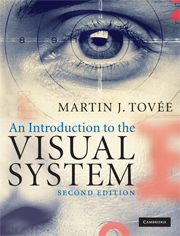Book contents
- Frontmatter
- Contents
- 1 Introduction
- 2 The eye and forming the image
- 3 Retinal colour vision
- 4 The organisation of the visual system
- 5 Primary visual cortex
- 6 Visual development: an activity-dependent process
- 7 Colour constancy
- 8 Object perception and recognition
- 9 Face recognition and interpretation
- 10 Motion perception
- 11 Brain and space
- 12 What is perception?
- References
- Index
- Plate sections
2 - The eye and forming the image
Published online by Cambridge University Press: 05 June 2012
- Frontmatter
- Contents
- 1 Introduction
- 2 The eye and forming the image
- 3 Retinal colour vision
- 4 The organisation of the visual system
- 5 Primary visual cortex
- 6 Visual development: an activity-dependent process
- 7 Colour constancy
- 8 Object perception and recognition
- 9 Face recognition and interpretation
- 10 Motion perception
- 11 Brain and space
- 12 What is perception?
- References
- Index
- Plate sections
Summary
What is the eye for?
In this chapter we will review the purpose of the eye and how the complex optical and neural machinery within it functions to perform this task. The basic function of the eye is to catch and focus light on to a thin layer of specially adapted sensory receptor cells that line the back of the eye. The eyeball is connected to an elaborate arrangement of muscles that allow it to move to follow target stimuli in the environment. The lens within the eye, which helps focus light, is also connected to muscles that can alter the lens shape and thus its focal length. This allows target stimuli at different distances to be focused on the back of the eye. At the back of the eye, light energy is transformed into a neural signal by specialised receptor cells. This signal is modified in the retina, to emphasise changes and discontinuities in illumination, before the signal travels onto the brain via the optic nerve. In the sections that follow we will examine these procedures in detail.
Light
Light has a dual nature, being considered both an electromagnetic wave, which can vary in frequency and wavelength, and also a series of discrete packets of energy, called photons. Both forms of description are used in explaining how the visual system responds to light. In determining the sensitivity of the visual system to light, such as the minimum threshold of light detection, it is usual to refer to light in terms of photons.
- Type
- Chapter
- Information
- An Introduction to the Visual System , pp. 18 - 43Publisher: Cambridge University PressPrint publication year: 2008



